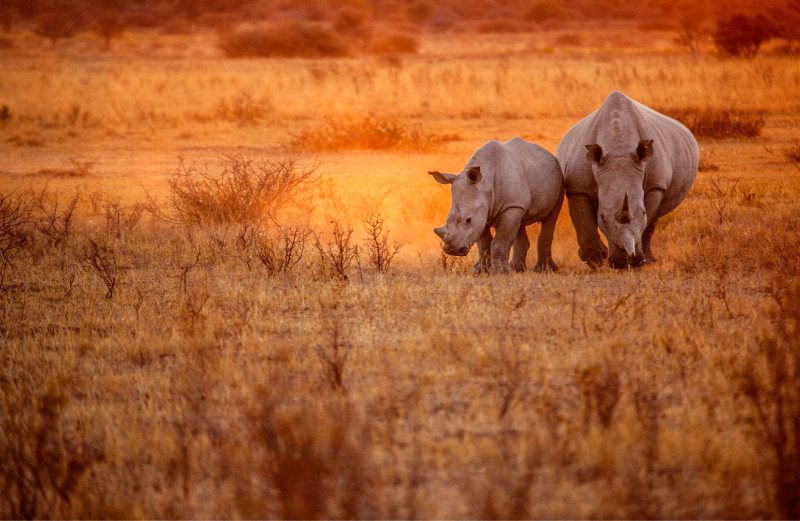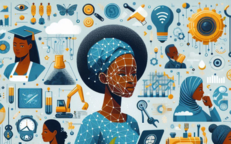Combatting Poaching And Illegal Logging In Africa Through Conservation Technologies

This is the 31st post in a blog series to be published in 2021 by the Secretariat on behalf of the AU High-Level Panel on Emerging Technologies (APET) and the Calestous Juma Executive Dialogues (CJED)
The African continent is endowed with an enormous diversity of natural ecosystems comprising a substantial range of flora and fauna. The continent possesses unique species of wildlife that are uniquely African.
Unfortunately, Africa has persistent wildlife crimes that are particularly deterring Africa’s efforts towards wildlife conservation. Poaching of fauna and illegal harvesting of flora have devastating effects on Africa’s wildlife populations; thus, threatening the survival of a wide variety of wildlife species across the African continent. Furthermore, all forms of wildlife trafficking remain persistent as a form of lucrative illicit trade across the African continent.[1]
Notably, poachers capture and kill wild animals to trade them in illegal local and global markets. Wildlife trade is predominantly conducted on illegal markets that have unfortunately expanded with the augmentation of e-commerce platforms promoted by dark and social media websites. For example, reptiles, primates, and birds are captured alive to trade them as exotic pets. Wealthy people and zookeepers commonly practise this for sport and display. On the other hand, slaughtered and poached wildlife animals are commercially valuable as food, jewellery, decoration; and sometimes utilised as traditional medicine. Wildlife meat is also considered a delicacy in several African countries and globally. In some communities, the tasks of elephants are curved into jewels and ornaments and animals such as the pangolin scales and rhino horns are utilised in traditional medicines, more especially in Asia.
The African Union aims to tackle the challenges generated by unsustainable poaching of Africa’s wild fauna and flora. African countries are concerned by the illegal trade of wild flora and fauna that has been progressively expanding in recent years. Such illegal activities dent Africa’s sustainable socio-economic development efforts, peace, security, the rule of law, and good governance as adopted in June 2014. To eradicate this, an Executive Council Decision EX.CL/Dec.832 (XXV) was adopted during the 23rd Ordinary Session held in Malabo, Equatorial Guinea.[2] The Malabo Decision specifically targeted illicit trade so to protect Africa’s wild fauna and flora. As a result, there were calls for collaboratively developing an African Strategy on Combating Illegal Exploitation and Illegal Trade in Wild Flora and Fauna.[3],[4] This strategy consolidated international commitments and declarations against illicit trafficking in wildlife. It augmented security and governance frameworks to eliminate the illegal exploitation and trade in wild fauna and flora in Africa.
In 2016, the United Nations (UN) estimated that illegal wildlife poaching was valued at US$23 billion annually.[5] Apart from poaching, Africa loses approximately US$ 17 billion annually towards illegal logging activities as the demand for timber is at an all-time high.[6] Unfortunately, the illegal logging activities of trees have negatively impacted millions of African livelihoods economically dependent on forests, as the loggers are displacing them. In addition, the erratic cutting down of trees has also resulted in climate change. Consequently, Africa is progressively facing life-threatening droughts and floods over the past decade.
Furthermore, poaching has devastatingly impacted the African continent wildlife, such as the extinction and endangering of some animal species. For example, the African pangolin has been declared an endangered species in Africa. Regrettably, the African pangolin is one of the most trafficked animals in Africa.
Black and white rhinos are also being mercilessly poached in Africa for their horns for traditional medicine applications. Wild gorillas, chimpanzees, elephants, green turtles, and wild dogs are amongst the highly poached animals. In addition, it has been reported that approximately 600 game rangers have died due to poaching occurrences between 2009 and 2016.[7] Furthermore, the poached animals have undergone cruelty and abuse after being displaced from their natural habitats. There have also been money laundering cases linked to poaching by African militias to fund their operations.[8]
African governments have formulated and implemented Africa wide strategic frameworks to combat illegal trade and exploitation of wild fauna and flora.[9] These strategic frameworks were formulated to increase political commitment to prevent, combat and eradicate illegal exploitation and illegal trade in wild fauna and flora. In addition, the frameworks were also implemented to improve governance, integrity and enhance regional, inter-regional cooperation. As such, African governments have increased game rangers and poaching penalties. Furthermore, there have been increased jail sentencing on poachers and illegal loggers to deter would-be offenders from committing wildlife crimes.
Unfortunately, illicit poaching and trading have become more sophisticated, and it has become challenging to apprehend potential offenders. Therefore, the African Union High Level Panel on Innovation and Emerging Technologies (APET) is encouraging African countries to increase efforts towards adopting technologies so to combat these crimes. For example, to combat South Africa’s rampant poaching of rhinos, the country has embraced emerging technology solutions necessary for tackling poaching corruption. For instance, a company called “Protect” has started implanting heart-rate monitors and embedding video cameras on South Africa’s Rhinos on their horns in National Parks and Game Reserves. Therefore, whenever the rhino’s heart rate erratically increases, a radio necklace transmits an alarm message along with GPS coordinates to the park officials. In response, game rangers are subsequently dispatched to monitor the alarmed animal.
Consequently, this technology enables rangers to track and protect game animals from poaching. In some cases, rhino horns are being poisoned with antiparasitic drugs and dyes to disfigure the rhino’s and deter the illicit trade of rhino’s horns. [10] However, the horn poison does not hurt the rhino but renders the horn useless to poachers.
APET is also urging African countries to adopt artificial drone technologies to protect wildlife efficiently. For example, Botswana, with the largest elephants’ population, have utilised drones to monitor and sufficiently protect the elephants. Fundamentally, drones are used for survey and management purposes. Thus, the animals can be counted within the landscape, generate data management systems, and enable recognition systems against potential threats to wildlife and their habitats.[11] The drones are also utilised to generate trees satellite imaging to monitor and manage illegal logging in remote areas.
The Ugandan government monitors gorillas in partnership with Inmarsat, a British satellite telecommunications company, through mobile technology solutions.[12] This mobile technology captures and streamlines data generated from human-wildlife conflict incidents. Thus, the mobile technology system provides real-time data that enables rangers to notify the community in real-time when the gorillas are within the community’s vicinity. Consequently, this has significantly decreased human-gorilla conflict occurrences in Uganda. Similarly, the animals are protected from danger, as well as neighbouring human communities.
Furthermore, APET advises African countries to enhance their efforts towards preventing and closing online illegal wildlife trafficking avenues that have exponentially expanded as enabled by social media and e-commerce platforms. Further to this, African countries can adopt smart technology to effectively detect illicit trading within the supply chain routes and interrupt the global access to illegal wildlife trade. Regrettably, trans-continental trade has expanded lately and thus contributing to the increased demand for Africa’s wildlife by other continents.[13] As such, this has complicated enforcement agencies’ abilities to detect illicit trading. This is especially complicated by the encrypted nature of the online transactions undertaken during illicit trading across e-commerce platforms.
Therefore, APET is supporting efforts of adopting artificial intelligence (AI) enabled digital technologies that can routinely scrutinise and probe substantial online data to prevent and disrupt illicit trade, promoting poaching effectively. For example, in 2018, the Worldwide Fund for Nature (WWF) and the International Fund for Animal Welfare (IFAW) launched the Coalition to End Wildlife Trafficking Online (CEWTO) campaign to discourage online illicit trading and poaching.[14] Through this initiative, 34 e-commerce, search, and social media technology companies are joining forces with wildlife organisations to tackle the illegal wildlife trade.[15] Furthermore, Baidu, a Chinese multinational technology company specialising in AI and the internet, collaborates with CEWTO to formulate and implement AI-based solutions suitable for detecting online listings and the sale of wildlife.[16]
In conclusion, APET is encouraging Africa’s Member States to urgently address the continent’s wildlife crimes and secure Africa’s unique fauna’s and flora’s ecosystem. This can be addressed by increasing efforts towards adopting smart technologies that can sufficiently reduce wildlife’s trafficking. Notably, the utilisation of modern technologies can potentially and adequately enable Africa’s ability to preserve its precious animals and plants in a collaborative and timely manner.
When it comes to wildlife, Africa can either come together and protect wildlife or do nothing and watch wildlife disappear forever.
Featured Bloggers – APET Secretariat
Justina Dugbazah
Barbara Glover
Bhekani Mbuli
Chifundo Kungade
[1] https://www.encyclopedie-environnement.org/en/life/restoring-savannas-and-tropical-herbaceous-ecosystems/.
[2] https://au.int/sites/default/files/decisions/9662-ex_cl_dec_813_-_850_xxv_e-1.pdf.
[3] https://wedocs.unep.org/handle/20.500.11822/20825.
[4] https://www.unep.org/resources/report/african-strategy-combating-illegal-exploitation-and-illegal-trade-wild-fauna-and.
[5] https://www.traffic.org/what-we-do/projects-and-approaches/wildlife-crime/.
[6] https://www.fairplanet.org/story/illegal-chinese-timber-business-that-is-devastating-african-forest/.
[7] https://www.nationalgeographic.com/animals/article/poaching-animals.
[8] https://www.govinfo.gov/content/pkg/CHRG-112shrg76689/html/CHRG-112shrg76689.htm.
[9] https://au.int/sites/default/files/documents/33796-doc-african_strategy_strategy_africaine_au.pdf.
[10] https://www.pri.org/stories/2015-03-22/poisoning-rhino-horns-doesnt-hurt-rhinos-it-may-keep-poachers-away.
[11] https://www.coverdrone.com/drones-trees-and-wildlife/.
[12] https://www.getaway.co.za/travel-news/technology-developed-to-protect-gorillas/.
[13] https://www.kas.de/documents/288143/11403695/Trends+in+Asia_AI-based+Strategies.pdf/65a39e6d-1f93-f69b-26e7-d8a19b156e26?version=1.0&t=1611289892785.
[14] https://www.worldwildlife.org/pages/coalition-to-end-wildlife-trafficking-online.
[15] https://www.traffic.org/news/leading-tech-companies-unite-to-stop-wildlife-traffickers/.
[16] https://www.ifaw.org/press-releases/ai-endangered-species-recognize-images-illegal-wildlife.


